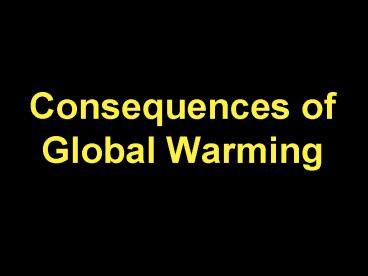Consequences of Global Warming - PowerPoint PPT Presentation
1 / 46
Title: Consequences of Global Warming
1
Consequences of Global Warming
2
Some Current Consequences of Global Warming
- More Severe Heat Waves of Greater Duration
- Sea-level Rise and Ocean Acidification
- Glacier, Ice Sheet and Permafrost Melting
- Spreading Disease
- Plant and Animal Range Shifts Plus Extinctions
- Coral Reef Degradation
- More Severe and Frequent Weather Events
- More Severe and Frequent Flooding
- More Severe Droughts and Fires
3
The Melting Earth
4
Mountain Glaciers
- Over 95 of mountain glaciers are shrinking
5
Glacial Mass Decrease from 1980 to 2004
6
Melting Glaciers
7
(No Transcript)
8
(No Transcript)
9
(No Transcript)
10
(No Transcript)
11
(No Transcript)
12
(No Transcript)
13
(No Transcript)
14
Rongbuk Glacier
Rongbuk glacier in 1968 (top) and 2007. The
largest glacier on Mount Everests northern
slopes feeds Rongbuk River.
15
(No Transcript)
16
Mt. Kilimanjaro Glacier Loss
17
Two Ice Sheets
18
The Arctic
19
Projected Temperature Change from 1990s to 2090s
(left) and Projected August Precipitation change
from 1980-1999 to 2070-2089 (right)
20
Decline in the Arctic WINTER Sea Ice
21
Arctic Summer Sea Ice Record Minimum (2007)
22
(No Transcript)
23
The Worst Scenarios of the IPCC Underestimated
the Amount of Summer Sea Ice Decline
24
Computer Model Simulation vs. Observed Decline of
Arctic Summer Sea Ice
25
Arctic sea ice area at summer minimum.
26
Age of Artic Sea Ice is Decreasing
27
How Will the Polar Bears Fare Under Global
Warming?
28
(No Transcript)
29
Greenland Melting (1992-2005)(Volume loss (2005)
240 km3 per year)
30
Greenland Total Melt Area 2007 value exceeds
last maximum by 10
Konrad Steffen and Russell Huff, CIRES,
University of Colorado at Boulder
31
Greenland Ice Sheet Melting
32
(No Transcript)
33
Greenland Ice Sheet Instability
34
Jakobshavn Glacier Contributing to Sea Level Rise
35
(No Transcript)
36
Decline in the Area of Arctic Permafrost
37
Projected Temperature Increase and Permafrost
Declineby the 2090s
38
(No Transcript)
39
Melting Permafrost in Siberia (Siberian CO2
equivalent release from land was 235 million
metric tons per year in 2006)
40
Accelerated Permafrost Melting
- The 2007 Arctic warming that caused the rapid and
extensive sea ice decline accelerated the melting
of permafrost. The accelerated warming extends up
to 1500 km inland. - If the recent trend in sea ice loss continues it
may triple Arctic warming, causing large
emissions of carbon dioxide and methane from the
tundra. - Simulated western Arctic land warming trends
during rapid sea ice loss are 3.5 times greater
than predicted 21st century climate-change
trends. - This could lead to a non-linear catastrophic
warming.
41
Methane Hydrate A Wake-up Call
42
Methane Hydrate Ice Burns
43
The Methane Hydrate Danger 1
- The frozen Arctic continental shelf off Siberia
has started to thaw and release long-stored
methane gas. The consequence could be an
unstoppable near- to long-term catastrophic
warming of the Earth. - In this region the carbon content of the methane
hydrates is estimated at 540 billion metric tons,
or the CO2 equivalent of 1.98 trillion metric
tons. - Methane hydrate in the shelfs sediments is
perilously close to thawing. Three to 12 km from
the coast the ocean sediment temperature is just
below freezing at -1 to -1.5 C. Permafrost on
land is as cold as -12.4 C.
44
The Methane Hydrate Danger 2
- The permafrost has grown porous and is becoming
unstable. The shelf has already become a source
of methane passing into the atmosphere. If this
Siberian permafrost-seal thaws completely and all
the stored gas escapes, the methane content of
the planet's atmosphere would increase
twelve-fold leading to a catastrophic rise in
temperature. - The Arctic Ocean is getting warmer as the summer
sea ice continues to recede and the ocean becomes
ice-free for extended periods. This will probably
result in the temperature of the continental
shelf sediments rising above freezing, releasing
vast quantities of methane to the atmosphere.
45
Warming of the Arctic Ocean 2000 to 2007
46
Methane Beginning to Increase After 8 Years of
Stability
- During the past 8 years the methane abundance has
been relatively stable due to industrial changes
in Russia, changes in the methods of rice
farming, and methane capture from landfill sites. - In 2007 the world methane abundance increased
0.5. - Based on carbon isotope analyses the methane is
of biogenic origin. - The source is probably the release from melting
permafrost, and the Siberian Arctic continental
slope methane hydrates. - We may now be entering a non-linear climate
response.































